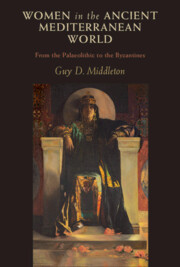Book contents
- Women in the Ancient Mediterranean World
- Women in the Ancient Mediterranean World
- Copyright page
- Dedication
- Epigraph
- Contents
- Preface
- Acknowledgements
- Timeline
- Historical Contexts
- Introduction
- Part I The Deep Past
- Part II The Bronze Age
- 4 Merneith
- 5 Šimatum and Kirum
- 6 The Woman of La Almoloya
- 7 The Priestess of Anemospilia
- 8 Hatshepsut
- 9 Puduhepa
- 10 Eritha and Karpathia
- 11 Hatiba
- Part III The Iron Age
- Part IV The Hellenistic Worlds
- Part V The Age of Empire
- Notes
- Select Bibliography
- Index
4 - Merneith
from Part II - The Bronze Age
Published online by Cambridge University Press: 19 January 2023
- Women in the Ancient Mediterranean World
- Women in the Ancient Mediterranean World
- Copyright page
- Dedication
- Epigraph
- Contents
- Preface
- Acknowledgements
- Timeline
- Historical Contexts
- Introduction
- Part I The Deep Past
- Part II The Bronze Age
- 4 Merneith
- 5 Šimatum and Kirum
- 6 The Woman of La Almoloya
- 7 The Priestess of Anemospilia
- 8 Hatshepsut
- 9 Puduhepa
- 10 Eritha and Karpathia
- 11 Hatiba
- Part III The Iron Age
- Part IV The Hellenistic Worlds
- Part V The Age of Empire
- Notes
- Select Bibliography
- Index
Summary
Ancient Egypt has fascinated the modern west since Napoleon’s campaigns took soldiers and scholars to the land of the Nile in 1798; the French and British came to blows there and many French discoveries were delivered into British possession – perhaps most notably the bilingual Rosetta Stone, which was key to the decipherment of ancient Egyptian hieroglyphics. This rather small black stone tablet can still be seen in the British Museum. The story of the discovery of Tutankhamun’s tomb by Howard Carter in the early twentieth century remains a television and publishing favourite, and there have been various tours of authentic objects, including to London’s Saatchi Gallery in 2019–2020; pyramids and mummies are more than ever objects of fascination and fantasy – and everyone knows the name Cleopatra.1 But the line of pharaohs stretched back far longer than Cleopatra and King Tut – it is sobering to recall that we are closer in time to Cleopatra than she was to the first pharaohs – and there have been many other intriguing and much more ancient discoveries in Egypt.
- Type
- Chapter
- Information
- Women in the Ancient Mediterranean WorldFrom the Palaeolithic to the Byzantines, pp. 55 - 61Publisher: Cambridge University PressPrint publication year: 2023

